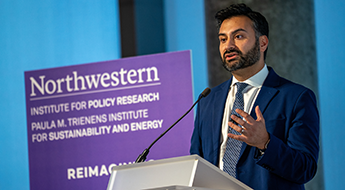How Did Illinois Child Care Programs Fare with COVID-19 Funding? A New Report Investigates
Findings by IPR developmental psychologist suggest good news for the state
Get all our news

Like many parts of the economy, the COVID-19 pandemic disrupted child care as 60% of programs nationwide were forced to close in spring 2020. It left parents and caregivers with no or few child care options, threatening their ability to work.
Since then, the federal government has provided $3.5 billion in direct child care relief aid to stabilize child care programs. States, including Illinois, also invested in child care programs to help stabilize them.
How did child care programs in Illinois distribute COVID-19 resources, and was it equitable? IPR developmental psychologist Terri Sabol, IPR-affiliated graduate students Tímea Virágh and Olivia Healy, and undergraduate researcher Anika Nerella, explore these questions in a new report.After analyzing 8,158 private child care programs in 757 eligible neighborhoods, out of a total of 1,393 neighborhoods in Illinois, the researchers find that Illinois did equitably grant funding to child care programs during the pandemic.
The researchers focus on three primary resources in Illinois: emergency daycare licenses, Paycheck Protection Program (PPP) loans, and Child Care Restoration Grants (CCRGs).
Illinois provided the emergency licenses during forced closures to programs serving essential workers' children. Federal investment from the Coronavirus Aid, Relief, and Economic Security (CARES) Act in 2020 funded PPP loans and CCRGs. Child care programs were eligible for the PPP, which provided forgivable loans to small businesses facing financial hardship due to the pandemic. CCRGs gave stipends to child care programs, depending on capacity and geographic location.
The findings show that approximately 15% of eligible child care programs in Illinois received emergency day care licenses, 25% of qualified child care programs received PPP loans, and 60% received a CCRG.
They also find few differences in the neighborhoods' characteristics based on income, employment, or race/ethnicity. However, they did discover that child care programs in urban areas were more likely to receive resources than those in rural areas.
Other key findings:
- The average amount that child care programs received from PPP loans was $58,705.
- The average amount that child care programs received from child care restoration grants was $64,615.
- Child care programs in urban areas were 3.5 times more likely to receive an emergency daycare license, 6.54 times more likely to receive a PPP loan, and 9.42 times more likely to receive a CCRG.
Terri Sabol is assistant professor of human development and social policy and an IPR fellow. Tímea Virágh and Olivia Healy are IPR-affiliated graduate students. Anika Nerella is an undergraduate student. All are at Northwestern University.
Photo credit: iStock
Published: September 9, 2021.


